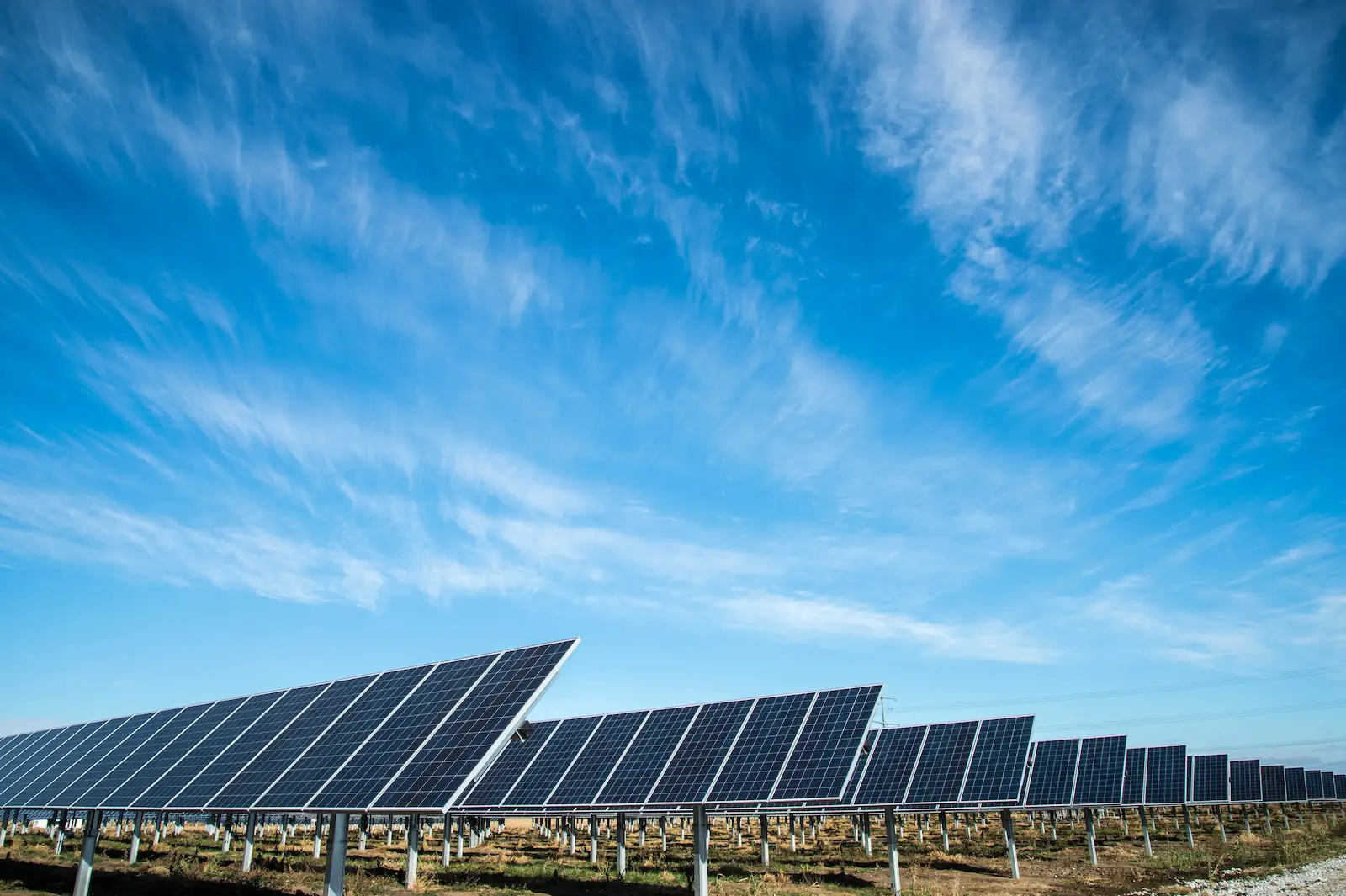Solar chargers have become popular for powering devices on the go, harnessing the sun’s energy to provide clean and efficient electricity.
A crucial aspect of using a solar charger is understanding its indicators, such as the blue or green flashing light.
In this blog post, we’ll explore what the blue flashing light on your solar charger means and how it can help you optimize your solar charging experience while addressing common questions and troubleshooting tips.
What Does the Blue Flashing Light on Solar Panel Indicate?
The blinking blue flashing light on a solar charger is an essential feature that provides vital information on its performance.
This light can indicate several charging states, including slow progress, potential overcharging, or low-light charging.
We will explore what the blue flashing light on a solar panel means and how it can help optimize your solar charging experience.
1. Signifies Charging is in Progress
One of the primary functions of the blue or green flashing light on a solar charger unit is to indicate that charging is actively in progress.
As solar panels convert sunlight into electricity, this energy flows into connected devices or batteries through the charger, ensuring they are replenished with power.
For example, when you set up your solar charger outdoors on a sunny day and connect it to your phone or another portable device, you should notice the blue light begin to flash.
This means that your device successfully draws power from the sun’s rays and recharges its battery.
2. Indicates Low Light Charging
Low light charging is another important aspect, signified by the blue flashing light on a solar charger.
This indicates that even though the charger is receiving inadequate sunlight, it’s still attempting to harness solar power and convert it into electricity for your devices.
An example of this can be seen during cloudy or overcast days, or when using a solar charger indoors near a window with limited sun exposure.
The blue LED will continue to flash as long as some form of sunlight reaches the panel, allowing the battery in your connected device to charge gradually despite less-than-ideal conditions.
3. Indicates Potential Overcharging
Recognizing potential overcharging is crucial to utilizing solar chargers efficiently and safely.
When the blue flashing light on your solar charger persists, notice that it may indicate that your device’s battery is approaching its maximum capacity.
To prevent this issue, use a solar charge controller that works as a regulator to manage the amount of solar power being fed into your devices.
The controller helps maintain appropriate charging levels by adjusting the electricity flow rate according to the batteries’ real-time capacity status.
How to Interpret the Blue Flashing Light?
Understanding the blue flashing light on your solar charger is crucial for maximizing its efficiency and avoiding potential issues.
To interpret this indicator correctly, pay attention to patterns and duration of flashing, check the instruction manual for specific indications, and understand that different meanings can be attributed based on the number of flashes.
Let’s find out how to interpret the blue flashing light on your solar charger and what different patterns and durations of flashes could indicate.
1. Pay Attention to Patterns and Duration of Flashing
To properly interpret the blue flashing light on your solar charger, it’s important to pay attention to the patterns and duration of flashing.
Different patterns can indicate charging statuses or errors, such as overcharging or low battery.
For example, some solar charge controllers have a flashing pattern that indicates a slow charging process due to low sunlight. In contrast, others may blink more rapidly when connected to an overloaded device.
Additionally, the duration of flashes can also be significant.
Longer flashes may indicate an error message, while shorter ones indicate normal operation.
2. Check the Instruction Manual for Specific Indications
It is essential to refer to the instruction manual for specific indications related to the blue flashing light on your solar charger.
Different manufacturers may have different meanings associated with blinking blue light. It is crucial to understand what the blue flashing light on the solar charger means your model signifies.
The manual will provide a detailed guide on interpreting this indicator, including patterns and duration of flashing and what they mean.
For example, some models might blink a blue or green light when charging in low-light conditions or when there is potential overcharging, while others may signal that charging is in progress or indicate slow charging.
3. Understand Different Meanings Based on the Number of Flashes
The number of flashes associated with the blue light on a solar charger can indicate different charging states.
For example, one flash may indicate the battery is low, while two flashes could mean it is charging.
Three or more flashes could suggest an issue with overcharging or other problems.
It’s essential to consult your instruction manual for specific indications because different brands and models may have varied meanings for their flashing lights.
For instance, Wyze Cam Outdoor has a solid blue light when successfully connected to WiFi and blinks continuously when pairing mode is activated.
However, it blinks three times per second when there’s a connection error.
What are some Troubleshooting Tips for a Solar Charger with a Blue Flashing Light?
If you’re experiencing a blue flashing light on your solar charger, don’t panic.
You can follow a few simple troubleshooting tips to ensure your charger is working properly.
Here are some steps to troubleshoot the issue and optimize your solar charger’s performance.
1. Ensure Proper Connection to the Device and Sunlight
When using a solar charger, ensuring a proper connection between your device and the charger is important.
The charger should be placed in an area with adequate sunlight exposure to optimize charging efficiency.
Here are some tips for ensuring proper connection to the device and sunlight:
- Make sure your device is compatible with the solar charger and that you are using the correct cable and connector for your specific device.
- Check that the solar panel and your device are clean and free from dust or debris that can interfere with charging.
- If you are having difficulty connecting your device, try adjusting the angle of the solar panel or moving it to a different location with better sunlight exposure.
- Be aware of any shadows or obstructions blocking sunlight from reaching the solar panel, hindering charging performance.
- Monitor the charging frequency and adjust it to ensure optimal performance.
By following these simple steps, you can improve solar charging and efficiency and extend the life of your devices powered by solar energy.
Always consult your instruction manual for specific instructions and indications for your particular solar charger model.
2. Check for Charger or Battery Damage
When troubleshooting a blue flashing light on your solar charger, it is important to check for any damage to the charger or battery.
Here are some tips for checking for the charger or battery damage:
- Inspect the charging cable: Check the entire length of your charging cable for any visible signs of wear and tear, such as frayed wires or splits in the insulation.
- Examine the ports: Check both the port on your solar charger and your device to ensure they are free of debris or visible damage.
- Look for cracks: Check the surface of your solar charger and battery for any cracks or dents that could indicate internal damage.
- Test with a multimeter: Use a multimeter to test whether there is voltage from your solar panel system and if it matches what is expected.
- Consult a professional: If you suspect that there may be damage to either your solar charger or battery, it may be best to consult a professional repair technician who can diagnose and fix the problem.
By regularly checking your solar charger and battery for any signs of damage, you can ensure that they remain in good working order and prevent potential issues from occurring down the line.
3. Adjust Settings as Necessary
When you encounter a blue flashing light on your solar charger, one of the troubleshooting tips is to adjust settings as necessary.
Below are some steps you can take to optimize your solar charger settings:
- Check the instruction manual for recommended settings based on the type of device you are charging.
- Adjust the voltage and current settings according to your device’s requirements.
- Monitor the charging frequency and adjust the settings as necessary to improve efficiency.
- Make sure that any power-saving or energy-efficient modes are turned off while charging your devices.
- Use compatible cables and connectors for your devices, as mismatched components may result in ineffective charging.
By adjusting these essential settings, you can ensure that your solar charger unit operates at its maximum efficiency and improves the lives of its recharge battery.
How Can You Optimize the Efficiency of a Solar Charger?
Solar chargers are an excellent way to power devices while on the go, but optimizing their efficiency is crucial to ensure they work as intended.
Let’s explore how to optimize the efficiency of a solar charger.
This includes positioning the charger for maximum sunlight exposure, using compatible components and equipment, monitoring charging frequency, and adjusting settings.
By following these tips, you can maximize the performance of your solar charger and keep your devices charged when you need them most.
1. Positioning the Charger for Maximum Sunlight Exposure
To get the most out of your solar charger, optimizing its exposure to sunlight is essential. Here are some tips for positioning your charger:
- Choose a clear spot: Place the charger in a location with as few obstacles blocking sunlight from reaching it.
- Angle the panel appropriately: Position the solar panel to face the sun directly.
The ideal angle will vary depending on your location, but you should aim for an angle equal to your latitude.
- Avoid shade: Ensure no branches or other light obstructions cast shadows or light down on the panel.
- Consider the time of day and seasons: In addition to choosing an optimal angle, be aware of where the sun is during different times and seasons.
Adjust the position of your panel accordingly.
- Keep it cool: Heat can reduce solar panel efficiency, so avoid placing your charger in direct sunlight for extended periods or in areas with high temperatures.
Optimizing exposure to sunlight can ensure that your solar charger will operate at peak efficiency and help keep your devices charged up when you need them most.
2. Use the Correct Cable and Connector for Your Device
To ensure optimal performance and efficiency for your solar charger, it’s crucial to use the correct cable and connector for your device.
Here are some tips to keep in mind:
- Check the compatibility of your device with the solar charger. Some devices may require a specific type of connector or cable.
- Use high-quality cables that are designed for solar applications. These cables are typically made with higher-quality materials and can handle higher voltage levels.
- Avoid using extension cords or low-quality cables, which can cause power loss and reduce charging efficiency.
- Consider the cable length you need based on where you plan to use your device. A longer cable may be necessary if you place your solar panel away from your device.
- Remember that different devices may have different charging requirements, so check the instructions or specifications for your specific device.
Using the correct cable and connector for your device helps ensure you get the most out of your solar charger and maximize its charging efficiency.
And remember to refer to Goal Zero’s website or user manual for additional troubleshooting tips or questions about using your solar charger!
3. Monitoring Charging Frequency and Adjusting as Necessary
To optimize your solar charger’s efficiency, monitoring the charging frequency regularly and adjusting it as necessary is crucial. Here are some essential tips for doing so:
- Keep a log of charging times and battery levels to determine any patterns or irregularities in the charging process.
- Adjust the positioning of the solar panel based on changing sunlight conditions to ensure maximum exposure and energy conversion.
- Use MPPT charge controllers to regulate voltage and current flow from solar panels to batteries, improving efficiency.
- Utilize float charge technology that compensates for self-discharge and maintains battery charge levels.
By monitoring charging frequency and making adjustments, you can maximize your solar charger’s performance and extend the life of your battery.
Incorporating MPPT controllers and float charging technology can significantly boost efficiency and reduce charging time.
4. Using Compatible Components and Equipment
Using compatible components and equipment is crucial to optimize the efficiency of your solar charger.
Here are some tips to ensure you’re using the right equipment:
- Purchase a solar panel that is compatible with your solar charger.
The wattage and voltage need to match for optimal charging.
- Use the correct cable and connector for your device.
Mismatched equipment can result in slow charging or even damage to your device.
- Consider purchasing a charge controller designed for your battery type.
Different types of batteries require different charging profiles, and a good controller will help ensure proper charging.
- If you’re using a solar charger for your Ring Doorbell, ensure it’s compatible with your specific model.
- Regularly check all components for any signs of wear or damage, and replace them as necessary.
By using compatible components and equipment, you’ll be able to maximize the power output from your solar charger, which means faster charging times and longer battery life for your devices.
What are Common Questions About Blue Flashing Lights on Solar Chargers?
Solar chargers are becoming increasingly popular due to their ability to charge electronic devices on the go using the sun’s energy.
However, many still have questions about their work and capabilities.
One common question is about the blue flashing light on solar chargers.
We’ll answer some of the most common questions about solar chargers, including how long it takes to charge a battery, the best positioning for solar panels, using a charger on cloudy days, and charging multiple devices simultaneously.
How Long Does It Take for a Battery to Charge on a Solar Charger?
The time it takes to charge a battery on a solar charger depends on various factors, such as the capacity of the attached battery and the wattage of the attached solar charger.
Generally, smaller batteries take less time to charge compared to larger ones.
It’s worth noting that other factors could affect charging times, including temperature and weather conditions.
Also, some smart chargers may require longer charging periods initially or for optimal performance.
What is the Best Way to Place a Solar Panel for Optimal Charging?
To achieve maximum charging efficiency, placing your solar panel in direct sunlight is essential.
The best location for optimal charging is an unobstructed area that receives high exposure to the sun throughout the day.
It’s important to avoid shading your solar panel. Even partial shade can significantly slow or reduce its output.
Also, consider placing your solar panel at an angle that maximizes its exposure to light.
This means tilting depending on whether you are in northern or southern latitudes.
Can I Use a Solar Charger on Cloudy Days?
Solar chargers are designed to harness solar power from the sun, but what about when it’s cloudy?
While solar panels do work best in direct sunlight, they can still generate some electricity to recharge you on cloudy days.
However, notice that the charging speed may be reduced or slowed down.
It’s important to note that the thicker the cloud coverage, the less energy your charger will produce.
Can I Charge Multiple Devices at Once With a Solar Charger?
Yes, you can charge multiple devices at once with a solar charger system by using a solar panel with enough wattage to accommodate the combined charging needs of your devices.
However, it is important to note that charging multiple devices simultaneously can slow down the system’s overall charging speed and may require longer exposure to sunlight for the batteries to charge fully.
According to Goal Zero’s frequently asked questions regarding their Yeti power stations, “Multiple electronic devices can be fully charged from one power station at once; however, output wattage will also share between them.”
Suppose you have a 100-watt solar panel connected to a Yeti 400 power station and three devices plugged in simultaneously. In that case, each device will receive roughly 33 watts of power while simultaneously fully charged.
In conclusion, understanding what the blue flashing light on the solar charger means for your solar charger is essential to optimizing its performance and ensuring proper battery maintenance.
By paying attention to patterns and duration of the flashing, checking instruction manuals for specific indications, and troubleshooting any issues, you can make the most out of your solar charging system.
Remember to always position your charger for maximum sunlight exposure, use compatible components and equipment, monitor charging frequency regularly, and adjust as necessary.
Reference:
- ZHC Solar | Solar Charge Controller Blinking & Flashing – https://zhcsolar.com/solar-charge-controller-blinking/
- Power Bank Expert | How do You Know Your Portable Charger is Fully Charged – https://www.powerbankexpert.com/how-do-you-know-when-your-portable-charger-is-fully-charged/








